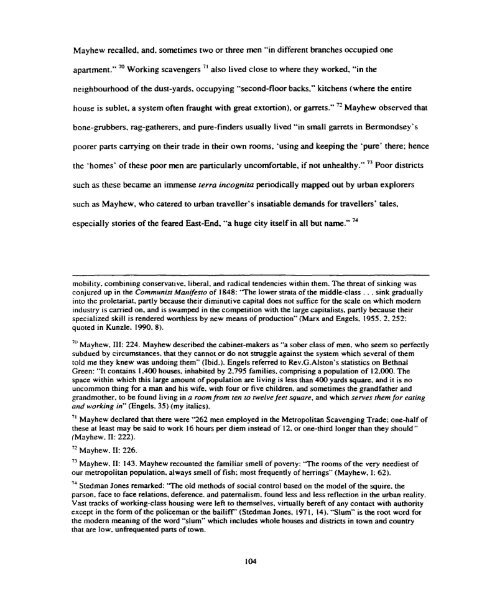Create successful ePaper yourself
Turn your PDF publications into a flip-book with our unique Google optimized e-Paper software.
Mayhew recalled, and. sometimes two or three men "in different branches occupied one<br />
apartment." 'O<br />
Working scavengers also lived close to where they worked, &"in the<br />
neighbourhood of the dust-yards, occupying "second-floor backs," kitchens (where the entire<br />
house is sublet. a system often fraught with great extortion), or garrets." " Mayhew observed that<br />
bone-grubbers, rag-gatherers, and pure-finders usually lived "in small garrets in Bermondsey's<br />
poorer parts carrying on their trade in their own rooms, 'using and keeping the 'pure' there; hence<br />
the 'homes' of these poor men are particularly uncornfortable. if not unhealthy." '' Poor districts<br />
such as these became an immense terra incognim periodically mapped out by urban explorers<br />
such as Mayhew, who catered to urban traveller's insatiable demands for travellers* tales,<br />
especially stories of the feared East-End. "a huge city itself in all but name." ''<br />
mobility. combining conservative. liberal, and radical tendencies within them. The threat of sinking was<br />
conjured up in the Communisr Manryesro of 1848: 'The lower strata of the middle-class . . . sink gradually<br />
into the proletariat, partly because their diminutive capital does not suffice for the scale on which modern<br />
industry is carried on, and is swamped in the competition with the large capitalists. partly because their<br />
specialized skill is rendered worthless by new means of production" (Marx and Engels, 1955. 2.252:<br />
quoted in Kunzle, 1990. 8).<br />
7()<br />
Mayhew. 111: 224. Mayhew described the cabinet-makers as "a sober class of men. who seem so perfectly<br />
subdued by circumstances, that they cannot or do not struggle against the system which several of them<br />
told me they knew was undoing them" (Ibid.). Engels referred to Rev.G.Alston's statistics on Bethnai<br />
Green: "It contains 1,400 houses. inhabited by 2.795 families. comprising a population of 12.000. The<br />
space within which this large amount of population are living is less than 400 yards square, and it is no<br />
uncommon thing for a man and his wife. with four or five children, and sometimes the grandfather and<br />
grandmother, to be found living in a room from ten to twelve feet square, and which serves !hem for eating<br />
and working in" (Engels. 35) (my italics).<br />
" Mayhew declared that there were '262 men employed in the Metropolitan Scavenging Trade; one-half of<br />
these at least may be said to work 16 hours per diem instead of 12, or one-third longer than they should"<br />
(Mayhew, 11: 222).<br />
" Mayhew. 11: 226.<br />
73<br />
Mayhew. 11: 143. Mayhew recounted the familiar smell of poverty: 'The rooms of the very neediest of<br />
our metropolitan population. always smell of fish; most frequently of herrings" (Mayhew, I: 62).<br />
74<br />
Stedman Jones remarked: 'The old methods of social control based on the model of the squire. the<br />
parson. face to face relations, deference. and paternalism. found less and less reflection in the urban reality.<br />
Vast tracks of working-class housing were left to themselves. virtually bereft of any contact with authority<br />
except in the form of the policeman or the bailiff' (Stedman Jones. 197 1. 14). "Slum" is the root word for<br />
the modern meaning of the word "slum" which includes whole houses and districts in town and country<br />
that are low. unfrequented parts of town.
















